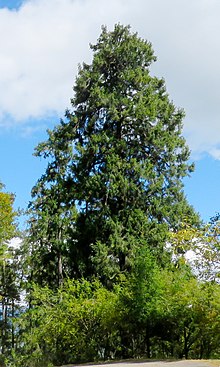| Sikkim spruce | |
|---|---|
 | |
| Scientific classification | |
| Kingdom: | Plantae |
| Clade: | Tracheophytes |
| Clade: | Gymnospermae |
| Division: | Pinophyta |
| Class: | Pinopsida |
| Order: | Pinales |
| Family: | Pinaceae |
| Genus: | Picea |
| Species: | P. spinulosa |
| Binomial name | |
| Picea spinulosa | |
| Synonyms [2] | |
| |
Picea spinulosa, the Sikkim spruce, is a spruce native to the eastern Himalaya, in India (Sikkim), Nepal and Bhutan. It grows at altitudes of 2,400-3,700 m in mixed coniferous forests.
It is a large evergreen tree growing to 40–55 m tall (exceptionally to 65 m), and with a trunk diameter of up to 1–2.5 m. It has a conical crown with level branches and usually pendulous branchlets.
The shoots are whitish to pale buff, and glabrous (hairless). The leaves are needle-like, 1.7-3.2 cm long, slender, rhombic to slightly flattened in cross-section, glossy green on the upper side, with two conspicuous blue-white stomatal bands on the lower side. The cones are cylindric-conic, 6–12 cm long and 2 cm broad, green or tinged reddish when young, maturing glossy orange-brown to red-brown and opening to 3 cm broad, 5–7 months after pollination; the scales are moderately stiff, with a bluntly pointed apex.
Sikkim spruce is occasionally grown as an ornamental tree in large gardens in western and central Europe for its attractive pendulous branchlets.
